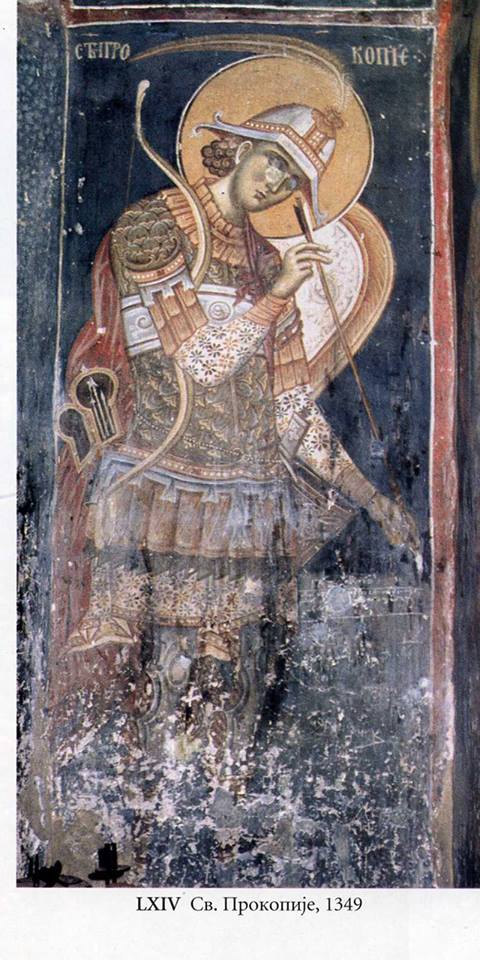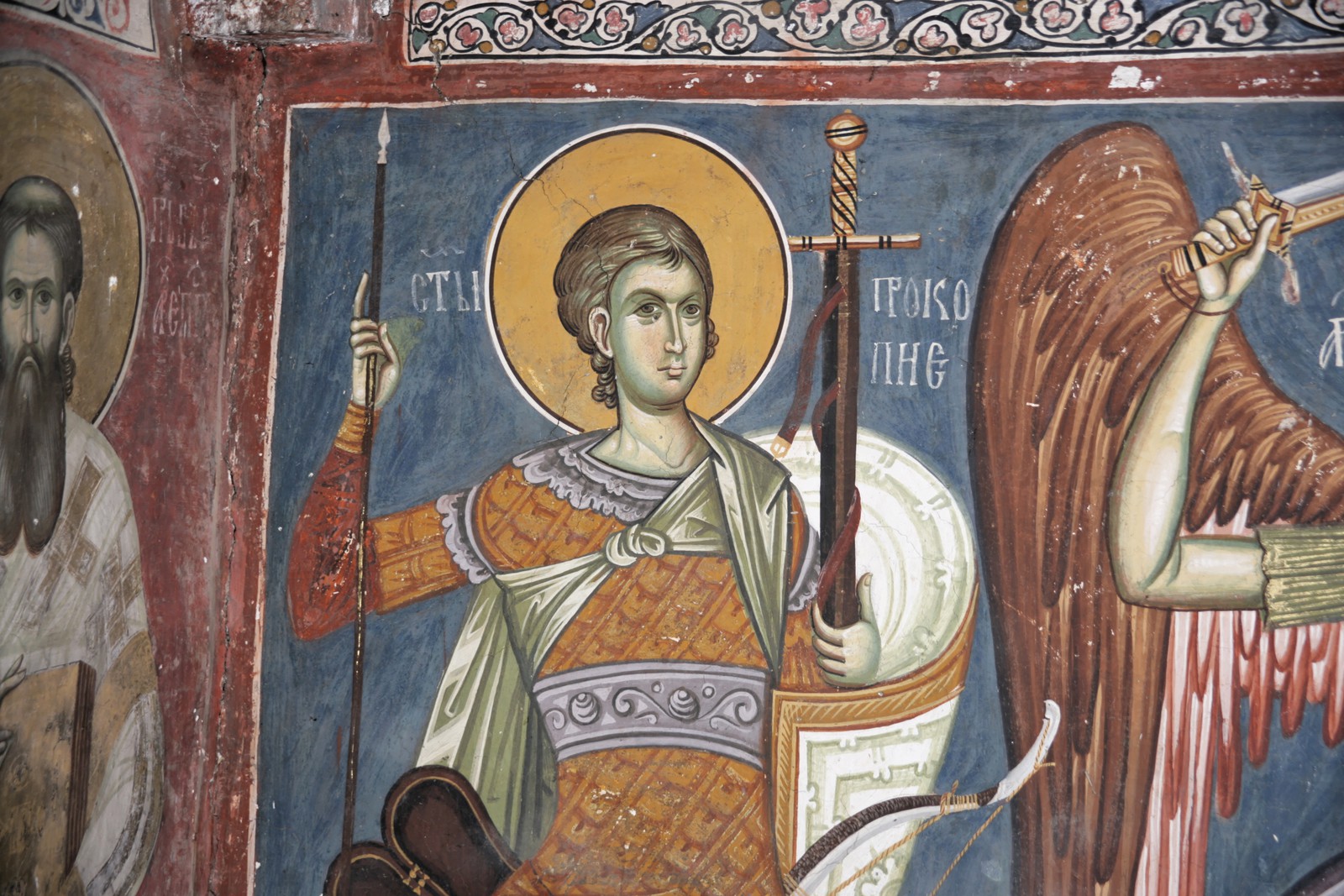Bows in Serbian Monasteries
Bows in Serbian Monasteries
Preserved in monasteries in the region known as the Balkans, fabulous depictions of Asiatic composite bows exist. These monasteries, particularly the Visoki Dečani and the Lesnovo monastery in modern-day Kosovo and North Macedonia, contain magnificent frescoes. They depict various characters, saints, martyrs, angels, and the like. These frescoes are interesting from archery and historical points of view because many of the characters are shown bearing Asiatic composite bows. These bows in Serbian monasteries were painted in the 1300s. They give us a glimpse into what these bows looked like. In fact, many modern bows are made in the Asiatic composite style, specifically by the renowned Serbian bowyer Misko Rovcanin of mrbows.com. This article explores some of the histories of the bows in Serbian monasteries.
Visoki Dečani Monastery
With over 1000 exquisitely preserved original frescos the Visoki Dečani Monastery is an artistic marvel. Located near the town of Deçan, in Kosovo, this religious building is relevant to our study of archery history because of the well-preserved depictions of strung bows. Bearing these bows, typically over their shoulders, these weapons would have been essential tools in the arsenal of the people in the area of the Balkans during the medieval period.
Before we go into the religious figures and some details about the bows, some more history on the Visoki Dečani Monastery is in order. The building was commissioned by Stefan Dečanski, King of Serbia in 1327 A.D. The king was buried in the yet-to-be-completed temple in 1331. His son, Stefan Dušan took the throne immediately after his father’s death and continued work on the monastery. The Franciscan friar Vito of Kotor was the central architect who oversaw the building construction. Construction was completed in 1335 after 8 years of building.

Monastery Location
The site of the monastery is beautiful. Lush forests, an abundance of water in the form of several springs, streams, and rivers define the countryside. Prokletije Mountains rise in the distance.
The Bulgarian writer and cleric Grigorije Camblak describes the location of the monastery as follows:
“Whilst visiting many and diverse places in my region, I found a place in the area of Hvostno called Dečani… adorned with every type of tree, for it is a place lush and fertile, and also flat and grassy, and the sweetest waters flow there from every direction, and abundant natural springs surface there and it is watered by a crystal clear river… it is enclosed from the west by the highest of mountains and their steep slopes, and hence the air there is wholesome. A large field adjoins to the east, which is irrigated by the same river. Such a place is, therefore, good and apt for the construction of a monastery”.

Bows in Serbian Monasteries: Ottoman Rule
The monastery came under the Ottoman dominion and remained as such until the 20th century. Many of the monastery’s landholdings which were gifted to it by Serbian royalty had been revoked. However, the monastery was left relatively intact and enjoyed some privileges under Ottoman laws. These laws however did not prevent a great deal of raiding, looting, and violence by the Turks and others over the centuries. The Balkans were a much-contested zone between the Austrians and Ottoman Turks during the medieval era.
19th Century to Modern Times
Due to its geography, the Balkans were always a battleground between much larger and militarily stronger nations. Russia, Austro-Hungary, and Turkey all sought influence over the region. The monks pleaded with Russian and Serbian royalty for protection from Muslim Albanians and also from the missionary efforts of Roman Catholic Austrians. The Austrians offered military protection and financial aid in exchange for union with the Pope of Rome.

In 1912 The Montenegrin Army, led by General Janko Vukotić, defeated the Albanians. He entered the Monastery on November 20, 1912, and venerated the holy relics of St. Stefan of Dečani.
The monastery remains a UNESCO World Heritage Site and preserves the late phase of Roman, Byzantine, and Gothic architecture. The sheer amount of art and relics, most made from the finest of materials, marble, precious metals and stones, silk, carved wood as well as beautiful paintings make it a sight to behold.
For more information on the monastery please visit its website: https://www.decani.org/
Bows in Serbian Monasteries: Saint Theodore Tiron
Saint Theodore Tiron became venerated as a warrior saint and Great Martyr in the Catholic Church, Oriental Orthodox Churches, and Eastern Orthodox Churches. As the legend would have it Theodore Tiron (Tīrō is a word from classical Latin meaning a “recently enlisted soldier or recruit”) served in the Roman army at Amasea (modern-day Turkey).
Theodore refused to partake in some Roman pagan ceremonies. He was subsequently arrested for a short time, then freed with a strict warning. Apparently, the warning was not harsh enough so he went on to protest Roman’s pagan ways by setting fire to the Magna Mater (Cybele) at Amasea. He was again arrested, and this time tortured. Being a true martyr he still refused to take part in the pagan ceremonies. As a result, he was burned at the stake. The year of his martyrdom is contested but some would have it as the year 287 (legenda aurea). Later sources have the date at 306 A.D. Butler (1759).
The likeness of Saint Theodore Tiron is depicted in great detail in a fresco from the Visoki Dečani Monastery.

Bowyer Miško Rovčanin
Hailing from Serbia, bowyer Miško Rovčanin produces historically inspired bows of a high caliber. In fact, some of his bows are directly inspired by the preserved frescos in monasteries. His model “Tiron”, named after Saint Theodore Tiron described above was produced from the study of the geometry of the bow depicted in the fresco of Saint Theodore in the Visoki Dečani Monastery.
With the assistance of professor Zoran Pavlovic, who has studied the history of archery in the Balkans the mighty Tiron came into being. The word mighty here is quite appropriate. Considering the fact that most of Miško’s bows can be produced from 25 to 150 pounds in draw weight! His bows are also renowned for their excellent quality of materials. Miško Rovčanin uses some modern materials such as fiberglass, as well as woods of all kinds. Some of his more exotic lumber include Plum, Pear, and Cherry as well as Zebra, Wenge, Paduk, Olive, and Purple Heart.
Check out his website here: http://mrbows.com/en/home/

Bows in Serbian Monasteries – Lesnovo Monastery
Another inspiration for one of Miško Rovčanin’s bows comes from a fresco in the Lesnovo Monastery. The Lesnovo Monastery is officially called the Monastery of St Archangel Michael and St Hermit Gabriel of Lesnovo. Founded in 1341 by Despotes Jovan Oliver Grčinić, a magnate of the Serbian kingdom who was the landlord of the surrounding area.
The monument is located in modern-day North Macedonia. The building was erected on the southwest slopes of Mt Osogovo, in the middle of a volcanic crater. This was a popular area for hermits in the 11th century A.D.
The inside of the monastery is wonderfully decorated with colorful and highly detailed frescos. One of these frescos depicts St. Procopius examining an arrow, with a bow slung over his shoulder.
This depiction would be the inspiration for another one of Miško Rovčanin’s historic bows, “The Despot”.




